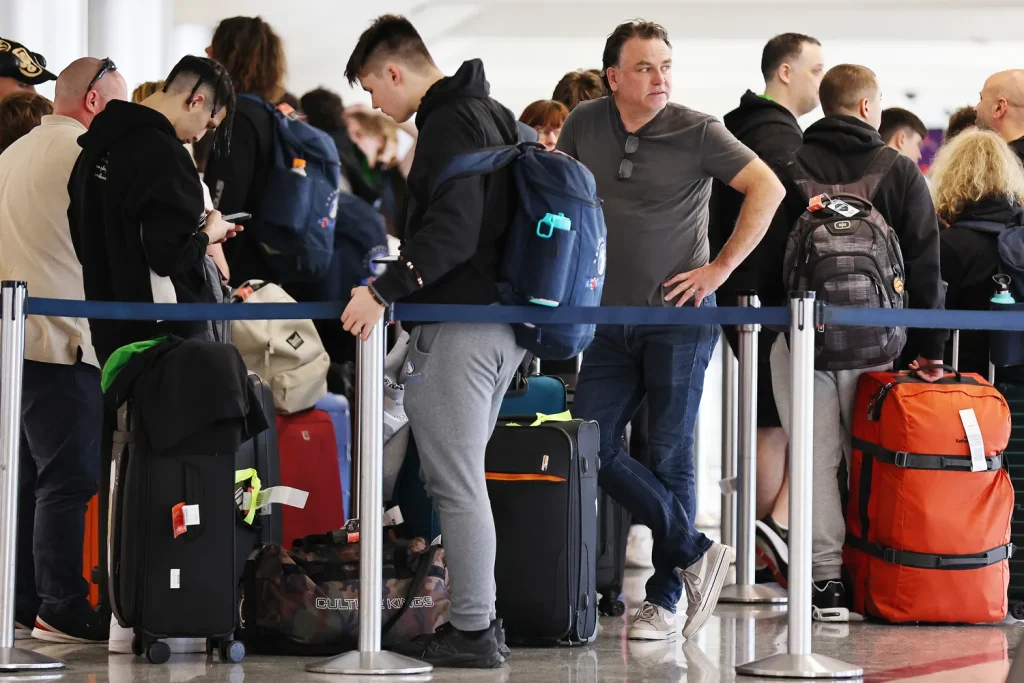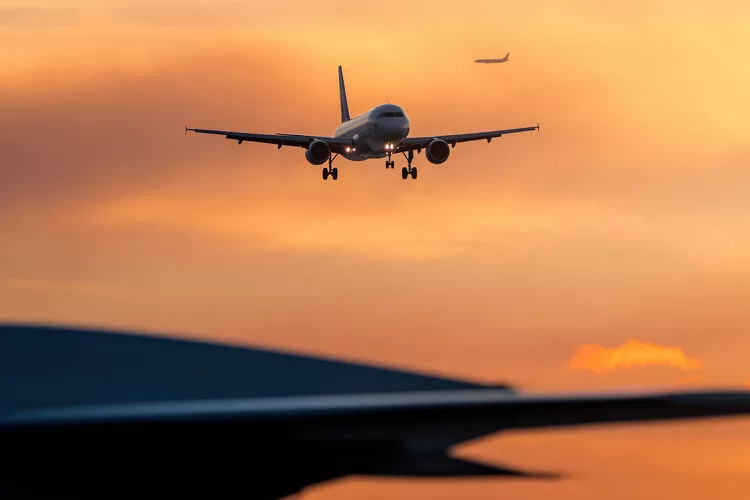Government Shutdown Forces FAA to Cut Flight Operations at 40 Major U.S. Airports — Thousands of Flights Could Be Canceled Daily as Staffing Crisis Deepens
Travelers across the United States are bracing for widespread disruptions as the Federal Aviation Administration announced plans to reduce air traffic at 40 major airports starting Friday, a move that could result in thousands of daily flight cancellations if the government shutdown continues.

The announcement, made during a press conference on Wednesday, marks one of the most consequential developments yet in the ongoing federal funding crisis. Transportation Secretary Sean Duffy and FAA Administrator Bryan Bedford said the decision was made out of “necessity and safety,” citing severe staffing shortages and the risk of overworked air traffic controllers operating without pay.
“This is not a decision we take lightly,” Bedford said, standing beside Duffy at FAA headquarters in Washington, D.C. “But the safety of our airspace comes first. With more than 13,000 air traffic controllers working without pay and hundreds more calling out due to stress and fatigue, we have no choice but to slow things down.”
The FAA’s list includes some of the country’s busiest airports — among them Los Angeles International (LAX), Hartsfield-Jackson Atlanta, Chicago O’Hare, Dallas/Fort Worth, Miami International, Denver International, Seattle-Tacoma, and all three major New York-area airports: JFK, LaGuardia, and Newark. According to estimates from aviation data firm Cirium, as many as 1,800 flights per day could be canceled or delayed, affecting more than a quarter million passengers daily.
For millions of travelers planning upcoming trips — from family vacations to business travel — the news comes as a gut punch. Holiday season travel typically begins ramping up in early November, and this year, airlines had expected record-breaking passenger numbers following a year of high demand. Now, many are left wondering whether their flights will take off at all.
Transportation officials stressed that this reduction is not a full grounding of air travel, but a controlled, partial slowdown designed to preserve safety margins. The FAA plans to initially cut capacity by 4 percent at select airports on Friday, with reductions climbing to 10 percent within a week if the shutdown persists. “Our goal is to minimize disruption while ensuring that every flight that does take off and land does so safely,” Bedford added.

The shutdown, now in its 36th day, has already forced hundreds of thousands of federal employees — including air traffic controllers and TSA agents — to work without pay. While most commercial pilots, airline staff, and maintenance workers remain on duty through private contracts, the aviation system depends on the FAA’s federal workforce to manage air traffic safely. The combination of unpaid shifts, overtime exhaustion, and growing morale concerns has led to a critical tipping point.
“Fatigue and distraction are enemies of safety,” Secretary Duffy warned. “When controllers are overworked and unpaid, it’s not just about inconvenience — it’s about risk. We are acting now to prevent that risk from escalating into something worse.”
Airlines, meanwhile, are scrambling to adapt. Delta, United, and American Airlines issued near-simultaneous statements within hours of the FAA’s press conference, assuring passengers that they are “working closely” with federal authorities to manage the impact. Many carriers have begun allowing passengers to change or cancel flights free of charge, regardless of fare type, for travel through the affected period.
At airports, signs of the strain are already visible. TSA wait times have ballooned, with reports of checkpoint closures at major hubs. In New York, LaGuardia’s Terminal B saw lines stretching beyond security areas early Thursday morning. In Atlanta, several Delta employees reportedly handed out water and snacks to waiting travelers as they explained the cause of delays — “the shutdown,” they said plainly.
For the FAA, the flight reductions are intended as a temporary solution, but one that underscores how deeply the government shutdown has infiltrated everyday American life. Air traffic control operations, once seen as untouchable, are now at the center of political gridlock.
Experts in the aviation industry say the decision could have ripple effects far beyond the next few days. “If you start pulling 10 percent of flights from the system, you’re not just canceling individual routes — you’re disrupting the entire network,” said Henry Hartwell, a former FAA official turned aviation consultant. “A cancellation in Dallas can ripple through Chicago, then to New York, then to Miami. It’s all connected.”
The economic implications are staggering. The U.S. Travel Association estimates that every day of flight disruptions costs the economy upwards of $300 million in lost productivity, tourism revenue, and business activity. Hotels, restaurants, and rental car agencies near major hubs are already reporting cancellations and reduced bookings.
Yet behind the numbers are millions of individual stories — travelers stranded, families forced to change plans, and airline workers bearing the brunt of passenger frustration. At Denver International Airport, one traveler described the scene as “tense but resigned.” “People are upset, but there’s not much anyone can do,” she said. “Everyone’s tired of hearing the word ‘shutdown.’”
Inside control towers, the atmosphere is equally grim. One veteran air traffic controller at Chicago O’Hare, who asked not to be named, told People that morale is at an all-time low. “We’re exhausted. Most of us haven’t seen a paycheck in over a month,” he said. “We love our jobs, but there’s only so long you can run on patriotism and coffee.”
Union leaders have warned that continued stress could push more controllers to call out sick, creating a dangerous feedback loop. “If even a small number of controllers take leave, the impact is exponential,” said Paul Rinaldi, former president of the National Air Traffic Controllers Association. “You can’t just replace these people overnight. It takes years to train new controllers.”
At Wednesday’s press conference, officials avoided assigning political blame, but the undertone was unmistakable. “The FAA doesn’t make funding decisions,” Bedford reminded reporters. “We work with what we’re given. Right now, we’re being asked to maintain the safest airspace in the world under conditions that are unsustainable.”
Lawmakers on both sides of the aisle reacted swiftly to the news. In Washington, senators from major travel hubs urged an immediate end to the shutdown, calling the FAA’s decision a “wake-up call.” Senator Tammy Duckworth of Illinois said, “Every hour this shutdown continues, our airspace grows less safe. This is no longer about politics — it’s about public safety.”
For ordinary travelers, though, the politics matter less than the practical reality. Airlines have advised passengers to monitor flight status apps and sign up for alerts. Passengers traveling through affected airports are also being told to arrive at least three hours early for domestic flights and four hours early for international departures, as security staffing may remain inconsistent.
By late Wednesday, social media was flooded with messages from anxious travelers, many expressing frustration while others shared sympathy for the workers caught in the middle. “These controllers are heroes,” wrote one user. “They’re keeping us safe without getting paid. The least we can do is be patient.”
For now, the FAA says it will continue evaluating staffing conditions daily and adjust the reductions as necessary. Should Congress reach a deal to reopen the government, officials promise flight schedules could be restored within 48 hours. But if the shutdown continues, even more drastic measures may be on the table, including the temporary closure of lower-traffic airspace and training facilities.
The next few days will be critical. For the FAA, the goal is to manage chaos without compromising safety. For travelers, it’s to navigate uncertainty with patience and preparation. And for Washington, it’s another reminder that political stalemate isn’t abstract — it’s felt in real time, in real airports, by real people watching departure boards flicker from “on time” to “canceled.”
The skies above America are about to get quieter — not by choice, but by necessity.



